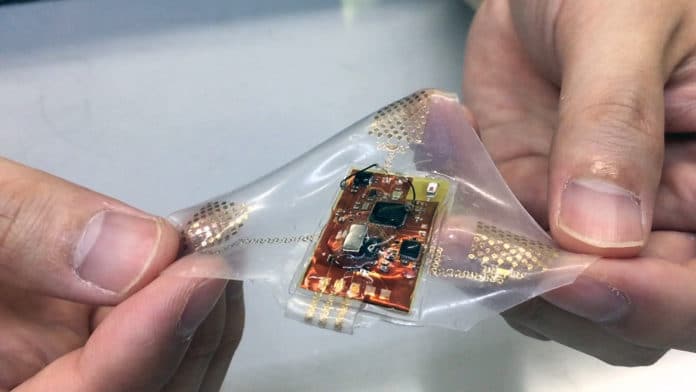Most commercially available health monitors rely on rigid electronic housing coupled with aggressive adhesives and conductive gels, which can cause discomfort and damage to the skin.
A team of scientists has developed a wireless, wearable monitor using stretchable hybrid electronics that could allow comfortable, long-term health monitoring of adults, babies, and small children. It is capable of real-time physiological monitoring without concern for skin injury or allergic reactions caused by conventional adhesive sensors with conductive gels.
This soft and comfortable monitor transmits electrocardiograms (ECGs), heart rate, respiratory rate, and motion activity data as much as 15 meters to a portable recording device such as a smartphone or tablet computer.
The electronics are mounted on a stretchable substrate and connected to gold, skin-like electrodes through printed connectors that can stretch with the medical film in which they are embedded. The hyperelastic construction allows the device to deform naturally with the user’s movement while providing sufficient adhesive force to adhere to the device throughout daily activities and strenuous exercises.
Because the device conforms to the skin, it avoids signal issues that can be created by the motion of the typical metal-gel electrodes across the skin. The device can even obtain accurate signals from a person who is walking, running, or climbing stairs.
A skin‐conformal, low‐modulus elastomer has shown negligible skin irritation.
“This health monitor has a key advantage for young children who are always moving since the soft conformal device can accommodate that activity with a gentle integration into the skin,” said Woon-Hong Yeo, an assistant professor at the Georgia Institute of Technology. “This is designed to meet the electronic health monitoring needs of people whose sensitive skin may be harmed by conventional monitors.”
The wearable monitor uses three gold electrodes embedded in the film containing the electronic processing equipment. The entire health monitor is just three inches in diameter, and a more advanced version under development will be half that size.
The wireless monitor is powered by an external power source, such as a miniature lithium‐ion polymer battery. But future versions, the researchers say, may replace the battery with an external radio-frequency charging system.
“When you put a conventional electrode on the chest, movement from sitting up or walking creates motion artifacts that are challenging to separate from the signals you want to measure,” Yeo said. “Because our device is soft and conformal, it moves with the skin and provides information that cannot be seen with the motion artifacts of conventional sensors.”
“The wearable monitor could be worn for multiple days, perhaps for as long as two weeks,” he added. “The membrane is waterproof, so an adult could take a shower while wearing it. After use, the electronic components can be recycled.”
Continuous evaluation with a wireless health monitor can improve the assessment of children and help clinicians identify earlier trends, potentially facilitating intervention before a condition progresses.
The team has developed two versions of the monitor, one of which is based on medical tape and designed for short-term use in a hospital or other care facility. The other one uses a soft elastomer medical film approved for use in wound care. The latter can remain on the skin longer.
The future plan involves reducing the size of the device and adding features to measure other health-related parameters such as temperature, blood oxygen, and blood pressure. A major milestone would be a clinical trial to evaluate performance against conventional health monitors.
The monitor has been studied in both animal models and humans. The details of the monitor are reported in the journal Advanced Science.
Journal Reference
- Yun-Soung Kim, Musa Mahmood, Yongkuk Lee, Nam Kyun Kim, Shinjae Kwon, Robert Herbert, Donghyun Kim, Hee Cheol Cho, Woon-Hong Yeo. All-in-One, Wireless, Stretchable Hybrid Electronics for Smart, Connected, and Ambulatory Physiological Monitoring. Advanced Science. Volume 6, Issue 17. DOI: 10.1002/advs.201900939
